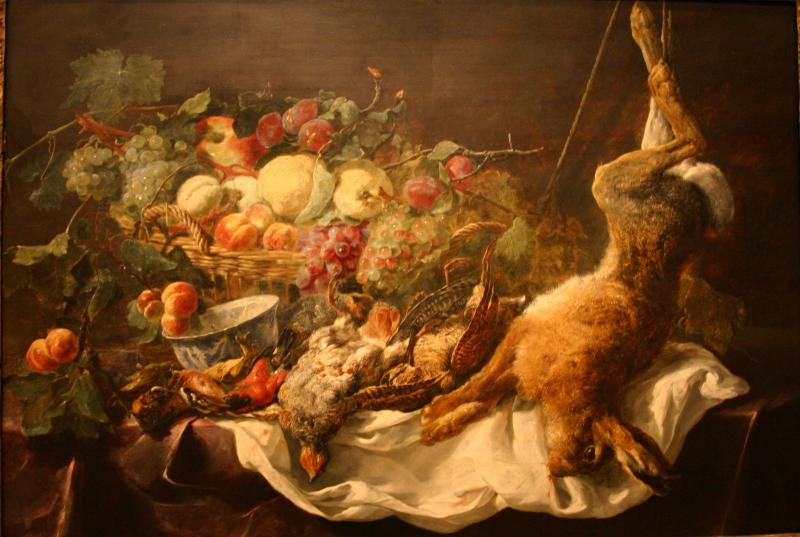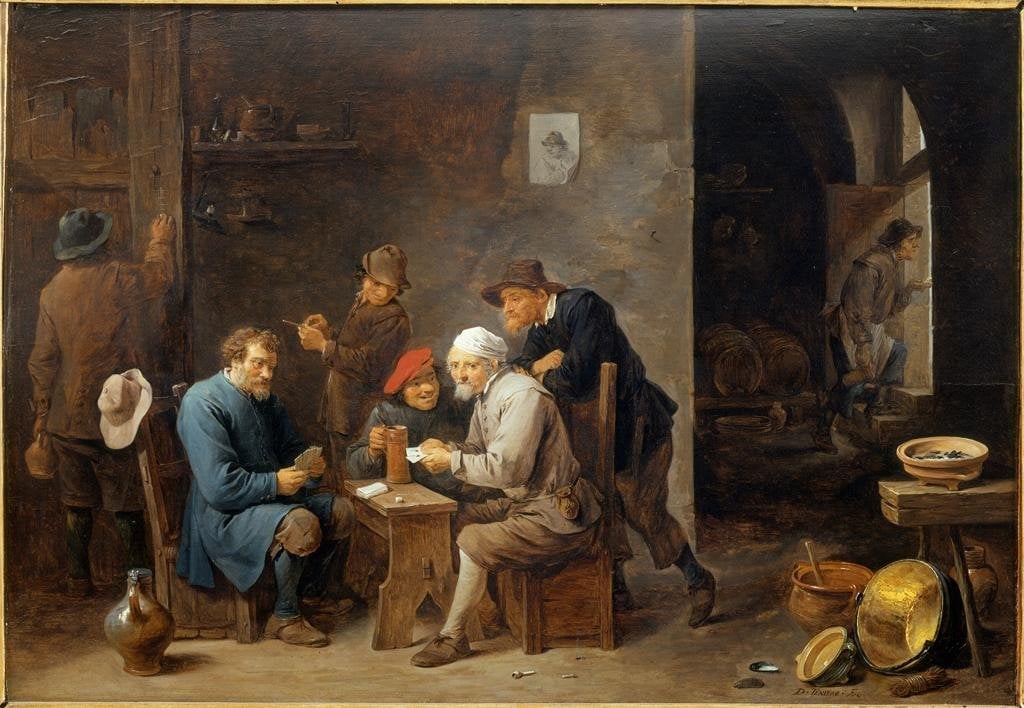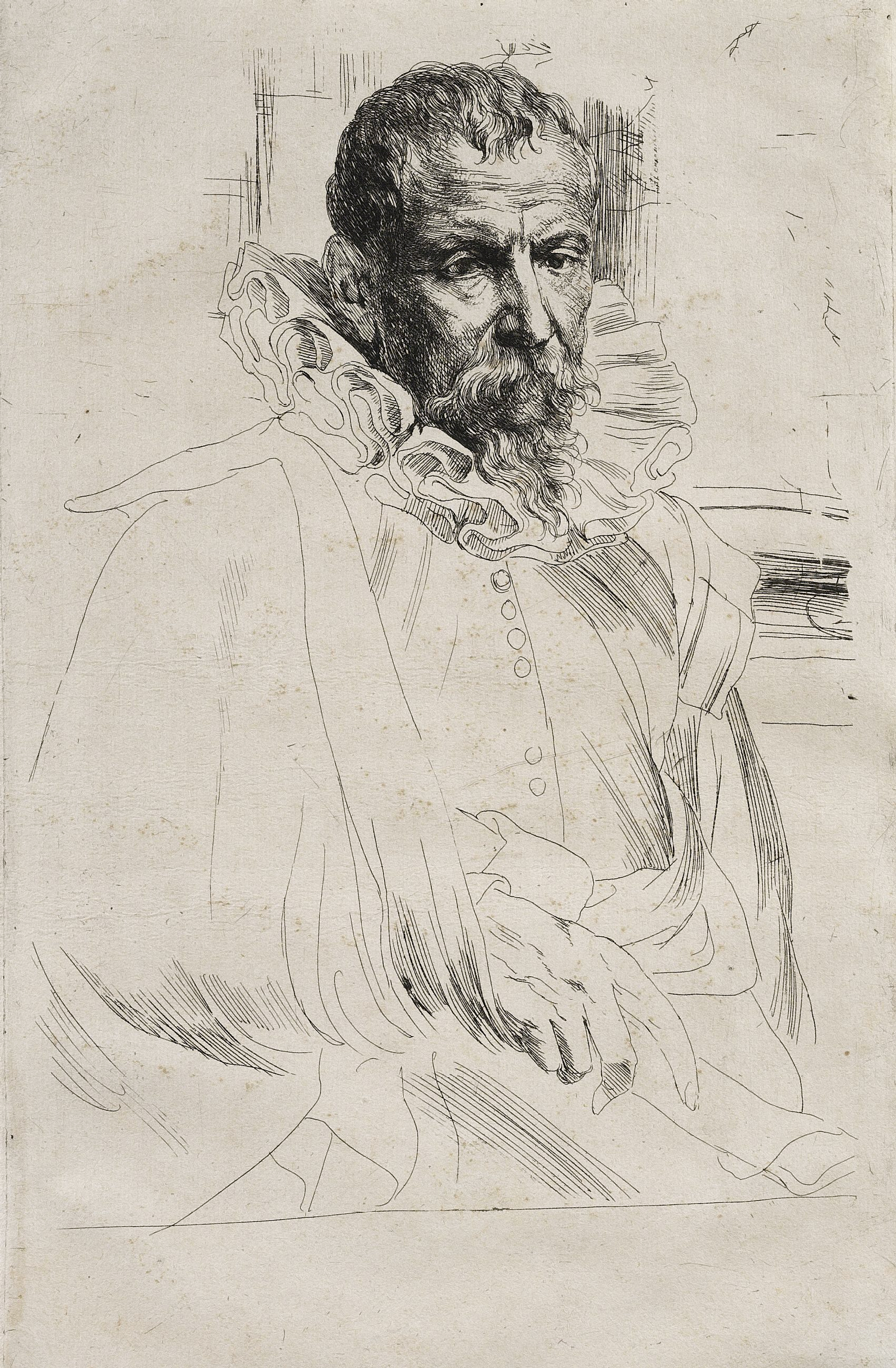5/21/2010
5/14/2010
Flemish painters - Jan Fyt -
Jan (or Johannes) Fyt (or Fijt) (March 15, 1611 – September 11, 1661) was a Flemish Baroque animal painter and etcher.
Born in Antwerp, where he was baptized on 15 June 1611, he was registered in 1621 as apprentice to Hans van den Berghe, who was a restorer of old pictures rather than a painter of new ones. Fyt then trained with Frans Snyders between about 1629-31, during which time, at the age of twenty, he entered the guild of St Luke as a master. From then until his death in 1661, he produced a vast number of paintings in which the bold facility of Frans Snyders is united to the powerful effects of Rembrandt, and harmonies of gorgeous tone are not less conspicuous than freedom of touch and a true semblance of nature.
He left Antwerp for Paris in 1633, travelling on to Italy the following year, where he worked in Venice and probably visited Rome (as he later joined the Guild of Romanists back in Antwerp). By 1641 he was back in Antwerp, where he married in 1654.
Fyt excelled in the rendering of animal life in its most varied forms. He may have been less correct in outline, less bold in action than Snyders, but he was much more skilful and more true in the reproduction of the coat of deer, dogs, greyhounds, hares and monkeys, whilst in realizing the plumage of peacocks, woodcocks, ducks, hawks, and cocks and hens, he had no equal, nor was any artist even of the Dutch school more effective in relieving his compositions with accessories of tinted cloth, porcelain ware, vases and fruit.
Anothr masterpiece of this fine flemish master is available as high quality print on our website, called Game Guarded by Dogs .
5/13/2010
Italian painters, Massimo Stanzione
Massimo was greatly influenced by Michelangelo Merisi da Caravaggio, but what earned him the nickname of The Neapolitan Guido Reni was his sophisticated and graceful style. The thing that distinguished Massimo’s art from Carravaggism was that he combined Caravaggio’s dramatically lit and brutally realistic style with the classical and lyrical manner of Bolognese painters.
Though his preliminary training is uncertain, it is thought that he studied with Fabrizio Santafede; however, most of the influence he received was from Caravaggio. Art historians believe that Stanzione developed his career as an artist in Rome. It is thought that he bagan his career as a portraitist. Some of his most famous works include Portrait of a Woman in Popular Costume, and Portrait of Jerome Banks. Between 1617 and 1630, it is believed that he traveled between the papal city and his hometown of Naples exploring different styles of art. Also influenced by Caravaggio were Artemisia Gentileschi, Simon Vouet, and Carlo Saraceni. During Stanzione’s career a movement that changed the style of art was formed. Stanzione was a part of this movement. This movement transformed the dark, contrasted Caravaggio-styled art into Bolognese colorism and soft art.
David With the Head of Goliath
In 1947, Mr. Harry Turpin gifted a Stanzione original painting titled David With the Head of Goliath. It has been hung in numerous galleries. The painting is dated to approximately 1603. Caravaggio was an important influence in Stanzione’s artistic style and this painting illustrates a combination of styles from Caravaggio’s brutally realistic elements and dramatic lighting to classical 17th century artistic trends including the lyrical style of Bologna artists. This painting shows David in an elegant posture, which softens the goriness, i.e. the dismembered head of Goliath. The theatrical lighting of this painting is a perfect demonstration of the chiaroscuro interpretation by Stanzione. Guido and Caravaggio can be credited for Stanzione’s interpretation of chiaroscuro; they were supposedly his teachers. Interestingly enough, it was only after the painting was donated, that experts noticed under gallery lighting some aberrations in the canvas such as unevenness and crackle patterns. Those aberrations, along with the fact that young David appears to be gazing at something in the lower left corner led to suspicions that the canvas had been altered. By 1999, with the use of x-rays and careful removal of surface paint, the original paint of Goliath’s forehead was revealed. After intensive restoration, Goliath’s full face was uncovered and the painting restored to its original form. The full painting depicts Goliath’s dismembered head in the lower left corner, with David, knife in hand, gazing down to the lower left corner. It is believed that the head of Goliath was painted over in order to make the painting less gory and more appealing to potential buyers.
Two of Stanzione's master works are available as printed reproduction on acurela.com :
5/12/2010
Flemish Painters -David Teniers the Younger-
David Teniers the Younger (December 15, 1610 – April 25, 1690), a Flemish artist born in Antwerp, was the more celebrated son of David Teniers the Elder, almost ranking in celebrity with Rubens and Van Dyck. His son David Teniers III and his grandson David Teniers IV were also painters. His wife Anna née, Anna Breughel was the daughter of Jan Brueghel the Elder and the granddaughter of Pieter Bruegel the Elder.
It is estimated the David Teniers II created over 900 paintings during his life-time. Many of them are in private collections, but over 200 of them are in public museums, and have been digitally catalogued.
You can find two of his masterpieces available for print on our website : The Consultation and Country Pub.
**source: wikipedia.org
5/07/2010
Dutch Painters -Philips Wouwerman-
Philips Wouwerman (also Wouwermans) (baptized May 24, 1619, Haarlem – May 19, 1668 Haarlem), was a Dutch painter of hunting, landscape and battle scenes.
Wouwerman was first taught by his father, Paul Joosten Wouwerman, an historical painter of moderate ability. According to a contemporary account he had also studied with Frans Hals (1581/85-1666). Wouwerman became a member of its guild of painters in 1642, and he died after a successful career in his hometown in May 1668.
Wouwerman's authentic works, spirited and polished, are of great variety, showing equestrian scenes, hunting and hawking parties, landscapes with travellers, cavalry battles and military encampments. He very commonly includes a white horse as a highlight in the foreground. He excels in his vivacious treatment of figures, skillful animal painting, and appropriate landscape backgrounds.
Wouwerman was first taught by his father, Paul Joosten Wouwerman, an historical painter of moderate ability. According to a contemporary account he had also studied with Frans Hals (1581/85-1666). Wouwerman became a member of its guild of painters in 1642, and he died after a successful career in his hometown in May 1668.
Wouwerman's authentic works, spirited and polished, are of great variety, showing equestrian scenes, hunting and hawking parties, landscapes with travellers, cavalry battles and military encampments. He very commonly includes a white horse as a highlight in the foreground. He excels in his vivacious treatment of figures, skillful animal painting, and appropriate landscape backgrounds.
You can find on our website to of his masterpieces available in print: - The Small Wooden Bridge- and also -Landscape with Packhorses-.
5/06/2010
Italian painters -Lorenzo Lotto-
Lorenzo Lotto (c. 1480 – 1556) was a Northern Italian painter draughtsman and illustrator, traditionally placed in the Venetian school. He painted mainly altarpieces, religious subjects and portraits. While he was active during the High Renaissance, he already constitutes, through his nervous and eccentric posings and distortions, a transitional stage to the first Florentine and Roman Mannerists of the 16th century.
During his lifetime, Lorenzo Lotto was a well-respected painter and certainly popular in Northern Italy. He was certainly not as highly regarded in Venice as in the other towns were he worked. He had an own stylistic individuality, even an idiosyncratic style. After his death, he gradually became neglected and then almost forgotten. This could be attributed to the fact that his oeuvre now remains in lesser known churches or in provincial musea. Even the top musea of the world possess each only a few of his paintings. Thanks to the work of the art historian Bernard Berenson, he was rediscovered and acclaimed as a master at the end of the 19th century. Since then, many monographs and several exhibitions have been dedicated to Lorenzo Lotto, such as the exhibition in Venice in 1953 and recently Lorenzo Lotto: Rediscovered Master of the Renaissance in the National Gallery of Art, Washington DC (November 1997-March 1998)
One of his masterpiece is available in print on our website, -Penitent Saint Jerome-, also here are just a few examples of his work: -Allegory of Virtue and Vice-, -Lotto's portrait of Andrea Odoni, 1527-, -Martyrdom of St. Claire-.
**source: wikipedia.org
5/04/2010
Flemish painters - Jacob Jordaens-
As well as being a successful painter, he was a prominent designer of tapestries.
Jordaens is known to have studied Titian, Veronese, Caravaggio, and Bassano, either through prints, copies or originals. His work, however, betrays local traditions, especially the genre traditions of Pieter Bruegel the Elder, in honestly depicting Flemish life with authenticity and showing common people in the act of celebratory expressions of life.
His commissions frequently came from wealthy local Flemish patrons and clergy, although later in his career he worked for courts and governments across Europe. Besides a large output of monumental oil paintings he was a prolific tapestry designer, a career that reflects his early training as a "watercolor" painter.
One of his masterpiece is available in print on our website, -Summer-, also here are just a few examples of his work: -The Satyr and the Peasant-, -As the Old Sang, So the Young Pipe-, -Prometheus-.
**source: wikipedia.org
4/29/2010
Italian painters -Antonello da Messina-
Antonello da Messina, properly Antonello di Giovanni di Antonio (c. 1430 — February 1479) was a Sicilian painter active during the Italian Renaissance. His work shows strong influences from Early Netherlandish painting and, unusually for a painter from Southern Italy, he was influential on the art of North Italy, especially Venice.
Antonello was born at Messina around 1429-1431, to Giovanni de Antonio Mazonus and Garita (Margherita). He was probably apprenticed in his native city and in Palermo.
Around the year 1450, according to a 1524 letter of the Neapolitan humanist Pietro Summonte, he was a pupil of the painter Niccolò Colantonio at Naples, then one of the most active centres of Renaissance arts.
Around 1455 he painted the so-called -Sibiu Crucifixion-, which was inspired by the Flemish Calvaries and is housed in the Muzeul de Artǎ in Bucharest. Of the same years is the -Crucifixion- masterpiece available for printing on our website, his early works shows a marked Flemish influence, which it is now understood he derived from his master Colantonio and from works by Rogier van der Weyden and Jan van Eyck.
**source: wikipedia.org
4/28/2010
Flemish painters-Hans Memling-
Flemish artist of German origin, active in the Netherlands in the second half of the XV century. Born in Seligenstadt, near Frankfurt in the Middle Rhein region, it is believed that Memling served his apprenticeship at Mainz or Cologne, and later worked in the Netherlands under Rogier van der Weyden (c. 1455–1460). He then went to Bruges around 1465.
His paintings are stored in museums and public art galleries: you can find on our website Acurela.com two of his masterpieces -Portrait of a Man Reading- and also -Portrait of a women at Prayer- other important pieces of his work are -The Virgin and Child between St James and St Dominic-, -Last Judgement, Triptych- and many others.
Labels:
Flemish,
German,
Hans Memling,
masterpieces,
paintings,
works
4/27/2010
Flemish painters -Pieter Brueghel II, The Younger-
Pieter Brueghel the Younger (1564 or 1565 – October 10, 1636) was a Flemish painter, known for numerous copies after his father Pieter Brueghel the Elder's paintings and nicknamed "Hell Brueghel" for his fantastic treatments of fire and grotesque imagery.
He painted landscapes, religious subjects and fantasy paintings. For this last category he often made use of fire and grotesque figures, leading to his nickname "Hell Brueghel".
Apart from these paintings of his own invention, Pieter Brueghel the Younger also copied the works his father had created by using a technique called pouncing. His genre paintings of peasants lack Pieter the Elder's subtlety and humanism, and emphasize the picturesque.
He painted landscapes, religious subjects and fantasy paintings. For this last category he often made use of fire and grotesque figures, leading to his nickname "Hell Brueghel".
Apart from these paintings of his own invention, Pieter Brueghel the Younger also copied the works his father had created by using a technique called pouncing. His genre paintings of peasants lack Pieter the Elder's subtlety and humanism, and emphasize the picturesque.
Regarding his work, pieter Brueghel painted the masterpieces: -Winter Landscape with Bird Trap- available for printing, on our website and an other work of his would be the -The Village Lawyer-.
Subscribe to:
Posts (Atom)














